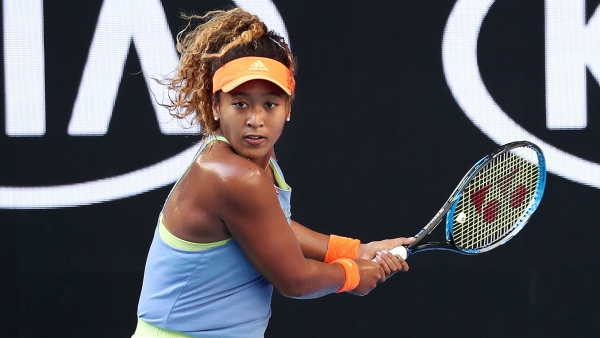Few players at AO2019 will be more closely followed than Naomi Osaka. The newest Grand Slam champion was the most-searched name in the game in 2018, following her sensational US Open victory over childhood idol Serena Williams.
Not the least impressive was the 20-year-old’s composure as controversy engulfed the last few games of the final and its aftermath. “When I step onto the court, I’m not a Serena fan,” Osaka articulated beautifully as a newly-minted major winner. “I’m just a tennis player playing another tennis player. But then when I hugged her at the net, I felt like a little kid again.”
Ranked 19, and with a solitary win on North American hardcourts coming into the US Open, Osaka dropped just one set at Flushing Meadows - to fellow rising star Aryna Sabalenka in the fourth round. Her winner’s cheque of $US3.8 million more than doubled her career prize money. And as Japan’s first Grand Slam champion, Osaka hit an endorsement jackpot, signing with Citizen watches, Nissin noodles, cable broadcaster Wowow and carmaker Nissan, alongside standing deals with Yonex racquets and adidas apparel.
Osaka’s youth, bold-hitting game and cross-cultural appeal - with a Japanese mother and Haitian father - led Forbes to describe the now 21-year-old as “the face of global tennis for the next decade.” Wowow’s Japanese TV audience for the US Open final was nine times greater than in 2017, while host broadcaster ESPN put the US audience for the women’s final at 50 percent bigger than for the men’s decider.

Osaka, who carries her mother’s family name (remarkably also the name of her hometown, Japan’s second-biggest city), has lived in the US since the age of three - first in Queens, New York, and since 2006 in south Florida. Stuart Duguid, her manager at IMG, says she has the potential to be “an ambassador for change”. But Osaka brushes aside talk of her reach as a biracial athlete. “I just think ‘I am me,’” she says of straddling cultures. “So when someone asks me a question like that, it really throws me off because then I really have to think about it.”
The US Open was incredibly Osaka’s second pro title. The first was also a biggie - Indian Wells in March, when the then-No.44 upended three No.1s - Maria Sharapova, Karolina Pliskova and incumbent Simona Halep - without dropping a set, before defeating fellow giant-killer Daria Kasatkina, ranked 25 places higher, in the final.
Indian Wells was as notable for Osaka’s rambling, endearing victory speech - “This is probably going to be the worst acceptance speech of all time,” she apologised. She was too fearful to hoist the heavy crystal trophy.
Although she grew up speaking Japanese with her mother Tamaki, names Tokyo as her favourite city and has grandparents in Hokkaido, Osaka has said: “My tennis is not very Japanese.” Indeed, at an imposing 180cm, Osaka’s offensive shotmaking is not the pin-neat, consistent, counterpunching bromide of Japanese tennis, as exemplified by Kei Nishikori and Kimiko Date, whom she has equalled as the highest-ever ranked Japanese at No.4.
At Melbourne Park a year ago, Osaka had dipped to No.72, before top-20 wins over Elena Vesnina and Ashleigh Barty carried her to the fourth round and a loss to No.1 Halep, marking the start of her upswing. She finished the season with a 42-20 record, winning two of three finals (her only loss to No.8 Pliskova in Tokyo straight after the US Open) and six quality wins over former or reigning No.1s, including Victoria Azarenka and two victories over Serena.
“It’s been a crazy year,” Osaka said at the WTA Finals in Singapore, where she limped out of 2018 with a hamstring injury. “A lot has happened. For me, it’s just been a lot of new experiences. For sure I feel like I have matured.
“I feel like I’m more… I wouldn’t say confident, but more like, I have inner peace. I don’t know. Like zen. Like I can go inside myself and be like peaceful. I think maybe in the beginning of the year I was very uncertain with what I was doing. But now I feel a bit more calm.”
Osaka’s bold-hitting style attracted attention from the outset. She made her Grand Slam debut at Australian Open 2016, reaching the third round, and climbed to No.40 on her 19th birthday. Serena Williams had seen enough to dub Osaka “very dangerous.” By the end of 2017, although she had fallen to No. 68, all-time great Chris Evert tipped Osaka’s breakthrough in 2018.
Like Serena, her poor lead-up form proved irrelevant at Flushing Meadows. “Ever since I can remember,” she told the New York Times ahead of the US Open, “I played better against bigger players on bigger courts.” Another powerful similarity with Serena is that Osaka has an older sister, Mari, who preceded her in the game. In the early days, admitted Osaka, she didn’t particularly love hitting the ball. “The main thing was that I wanted to beat my sister.”
Osaka’s priority in the off-season? “Just see my dog.” She isn’t one for lavish holidays - “I have never had a vacation” - or looking back. “Result-wise, definitely it was the best season I have had,” she considered in Singapore. “But I don’t know. For me, I’m always looking forward to the future. I shouldn’t just be doing well on hard courts, I’m capable of doing well on all surfaces. Definitely I want to focus on that [in 2019].”
There’s also the almighty challenge of “Keeping the level I had from [the] US Open... doing that throughout the entire year.” The whole tennis world will be watching.